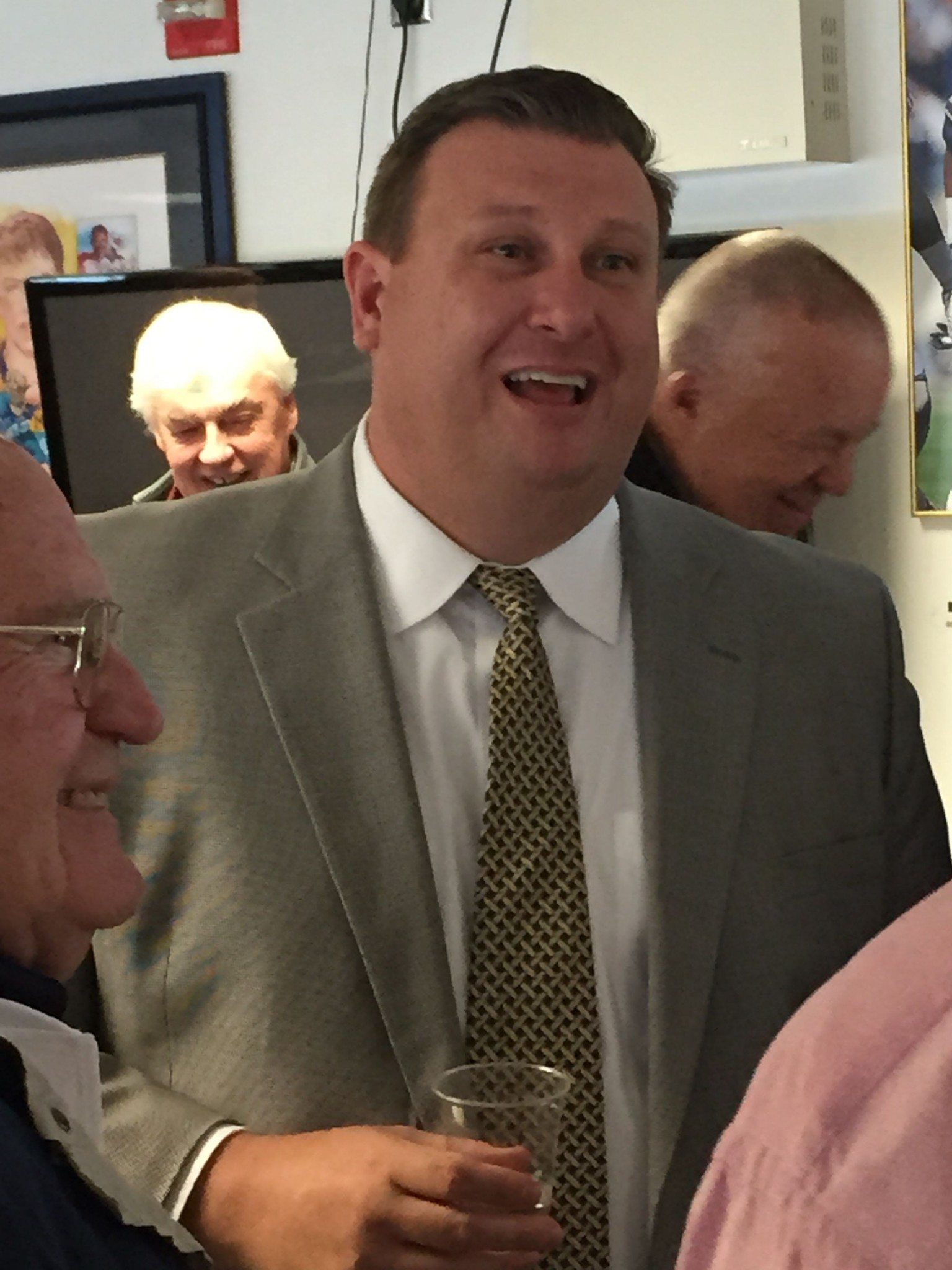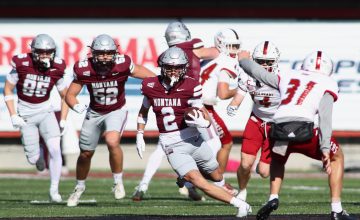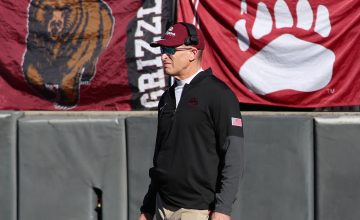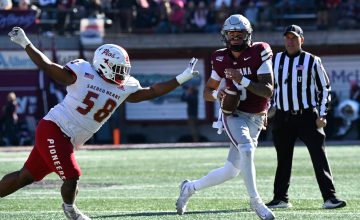Cooper Jones compares his fundraising technique to the fundamentals of football. He hopes to employ those basics if he becomes Montana State’s next athletic director.
Jones, currently the executive associate athletic director for the Sun Devil Club at Arizona State, interviewed at Montana State for the vacancy left by the non-renewal of Peter Fields’ contract after 14 years at the helm.
The former Ohio University football player has spent four years in Tempe after three years reinvigorating a fledging North Texas program. He has also held development positions at Louisville, Maryland and Georgia Tech. He estimates he has helped raised more than $450 million since first beginning his work in athletic administration 16 years ago.
“Certainly from a fundraising perspective, I call it the simple blocking and tackling philosophy,” the three-year letter winner and Ohio journalism major said after meeting and greeting roughly five-dozen people at the Stadium Club at Bobcat Stadium for an hour on Thursday evening. “You have to send renewals on time. You have to thank people. You have to steward them for their gifts. Sometimes, those are overlooked and you come into a department and people say, ‘We’ve never done that.’ We have to make sure we have a good apparatus in place to make sure we do that.”
Montana State President Waded Cruzado’s office has made it clear that the ability to fundraise in the athletic sector will be a key to earning MSU’s AD position. The state of Montana does not allow tuition and fees to be used for athletic revenue or renovations. Instead, all money must come from ticket sales or funds raised in the private sector.
“The biggest challenge in my mind is people have been waiting to see who is going to be the leader and it hasn’t been done here in a while at a really high level,” Jones said. “Peter has some tremendous success. His academics are in a great way. You have some new coaches here that we really feel passionate about it. But that external piece is something people have told me all day, that’s where we really need to play close attention to.”
Jones is the fourth of five finalists that will visit the Montana State campus this week. The final finalist will be in Bozeman on Friday. Wyoming Deputy AD Matt Whisenant interviewed on Monday and Utah Deputy AD Kyle Brennan was on campus on Tuesday. Eastern Michigan Deputy AD Christian Spears interviewed on Wednesday.
“I was stunned, group after group after group, the authenticity of the people, the amount of caring they had for the school during all my meetings today,” Jones said. “Some that didn’t go to school here, some that did. Some that have been disengaged for 25 years, people who have been season ticket holders for 40. You expect in a group or two, you’ll see the passionate group. All day, I saw people who want to see this place succeed.”
Jones is in fourth year in Tempe as the executive associate athletic director for development and the executive director of the Sun Devil Club at Arizona State. Jones is responsible for all fundraising initiatives within ASU athletics and oversees the annual fund, major gift, planned & estate giving, young alumni, volunteer representative, letter winner and sports specific outreach programs for ASU.
Jones spearheaded the recent rebranding initiative at ASU. He also led the executive campaigns to renovate Sun Devil Stadium, Phoenix Municipal Stadium and Papago Park. As a senior member of the athletic department, he has participated in coaching searches, season ticket pricing, media relations efforts, academic benchmarks and the overall multi-year strategic plan for Sun Devil athletics.
“Since late 2012, we have raised $152 million for Sun Devil student athletes,” Jones said. “Over the next three years, we will have 20 of our 25 sports with new or renovated arenas. We have gone from the eighth-rated organization in the Pac 12 to the No. 1 dues paying organization in the (Pac) 12.”
In his first development position at Georgia Tech, his wife Tiffany’s alma mater, Jones was a part of a $90 million fundraising effort to fund new basketball and baseball facilities. When Ralph Friedgen transitioned from Georgia Tech offensive coordinator to Maryland head coach, Jones got a phone call with an offer to go to College Park in a similar position.
At Maryland, Jones was a part of the fundraising team that helped the $130 million project that resulted in the Comcast Center. He was a part of $500 million in facility upgrades at Louisville. He spearheaded the effort to build a mixed-use downtown basketball arena that is not owned by the university. During his time in Kentucky, Jones helped with projects that built an indoor football practice facility, a lacrosse facility and a field hockey facility. He also helped hire women’s basketball coach Jeff Walz, a former Maryland assistant that has led the Cardinals to two NCAA runner-up finishes and four Sweet 16s overall.
Following his time at Louisville, Jones came to a crossroads.
“I wondered if I should be a deputy AD, a sport administrator or an athletic director. I chose AD, but I felt I had a hole in his resume,” Jones said.
He realized his success had come at exclusively prestigious, elite athletic departments. So Jones took a job at the North Texas.
While at UNT, Jones was the chief fundraiser for Apogee Stadium, the $80 million campaign for a new on-campus facility which constituted the first major athletic facility upgrade in over 35 years. Jones had direct oversight of the Mean Green Club, the athletic scholarship fund at UNT. Under his leadership, annual membership levels rose over 250 percent and financial support increased over 225 percent in dollars raised during that same period of time.
“If you know anything about football in the state of Texas, you will know that you are irrelevant if you aren’t winning and we hadn’t done it in six or seven years,” Jones said. “When I was there, we did not have a winning record in football. But we were able to triple the annual fund with 150 percent new revenue in my three years there. We stopped talking about wins and losses. We started talking about the impact philanthropy has on the ability to attract the best and the brightest.”
Jones said he wanted to attack a project to build an indoor practice facility for the football team. He mentioned the indoor track surface, the weight room and the east stands at Bobcat stadium as priorities. He did not mention Brick Breeden Fieldhouse other than the indoor track.
“I’ll use my background in facilities management to say what are the priorities,” Jones said. “Then getting those coaches on board. Sometimes, you have to go have a difficult conversation and say I’m sorry but you are on the B list with this one and we will get to it. We are having to do it right now at Arizona State. We have a basketball coach with a big name (Bobby Hurley). He wanted Wells Fargo renovated Year 1 but he’s going to wait 40 years. It will be an awkward conversation to have but you have to do that.”
Jones went out of his way to talk about the mindset of the MSU supporters he observed during his first trip to Montana. He said it was one of the biggest challenges facing the university.
“The other issue is how do we change a mindset among a donor base that looks at the wins and losses and losses against Montana as the end all, be all,” Jones said. “That’s so important and there won’t be a sport here where that isn’t the goal but I want to expand our vision outside the borders of the state. I want to be great. You can’t be great by saying I just want to be great in this state. You have to do that but you have to be the best in the Big Sky, you have to be the best in mid-major, FCS. You have to do that by expanding your horizon.”
The Conyers, Georgia native speaks with a strong southern accent. With the exception of his latest stint in the desert, Jones has worked either in the south, at an institution with impressive tradition or both. Still, Bozeman had an element of familiarity different from his last few stops. A longtime friend lives in the Gallatin Valley, so he and Tiffany had dinner with familiar faces on Wednesday night. It was just one of the things the couple liked about their first trip to the Treasure State.
“Your fear is that you walk into a program where nobody cares,” Jones said. “That you are so heavily subsidized from the university that your students aren’t really appreciative where their gifts are going toward. This is not that place. This is a place people care deeply.”














